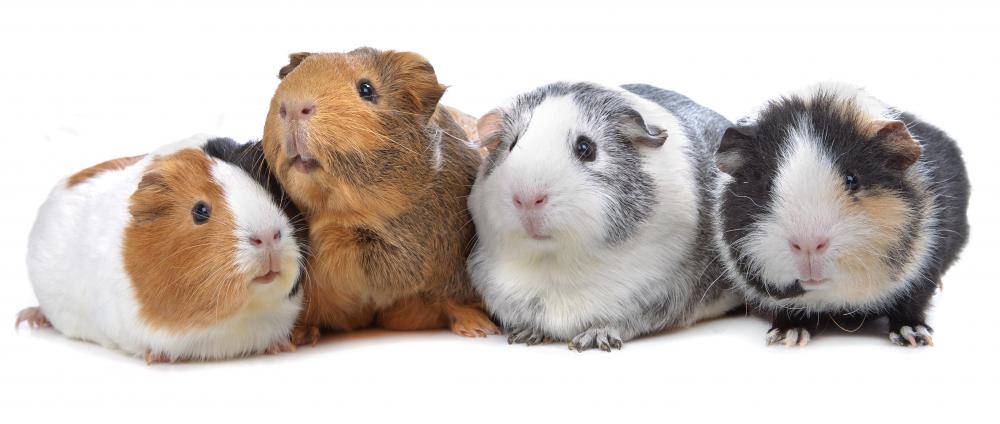At AllThingsNature, we're committed to delivering accurate, trustworthy information. Our expert-authored content is rigorously fact-checked and sourced from credible authorities. Discover how we uphold the highest standards in providing you with reliable knowledge.
What Are the Different Types of Guinea Pig Habitats?
There are a number of different guinea pig habitats available to people who wish to keep these rodents as pets. They can be easily kept in large, open pens or in cages that provide a large amount of floor space. Large containers, such as plastic swimming pools, can also be used as guinea pig habitats. Though there are many good choices for housing these animals, they should never be kept in small cages, cages with wire grates on the bottom, or glass tanks, as each of these environments pose health risks for the guinea pig.
One of the most common guinea pig habitats used in homes is a large wire pen. The walls of the enclosure do not need to be higher than a couple of feet, because most guinea pigs are not adept at climbing over barriers. A top is not usually needed if there are no other pets, such as dogs or cats, that could jump inside and injure the guinea pigs. These enclosures are ideal habitats because they provide a great deal of square footage, something that guinea pigs need an abundance of, and are generally inexpensive.

Large vertical cages can also be used as guinea pig habitats. These cages offer a lot of floor space but divide it between two or more levels. Though guinea pigs are not good climbers, when provided with ramps, they are able to move up and down between levels. In most cases, these cages will be completely enclosed, which makes it safer to keep guinea pigs in a house with other pets.

It is also possible to find guinea pig habitats that were not originally intended for use as such. Plastic children's pools and large plastic bins can be successfully used to house these animals. In most cases, the guinea pigs will not attempt to climb over the sides of these enclosures, though some will. Observing a guinea pig carefully in its new environment will help an owner determine whether that environment will be safe for the guinea pig. It is also important to make sure that the guinea pig does not chew on and eat the pieces of a plastic enclosure, which could sicken the animal.

In the wild, guinea pig habitats include grassland and rocky areas. They are found only in South America, with their range extending from Peru in the north through northern regions of Argentina in the south. They live in burrows in large family groups.
Frequently Asked Questions
What are the essential components of a guinea pig habitat?
A proper guinea pig habitat should include ample space for exercise, typically a minimum of 7.5 square feet for one guinea pig, according to the Humane Society. It should also have a solid floor, bedding for burrowing, areas for hiding, a feeding zone with hay, fresh water, and toys for enrichment.
Can guinea pigs live outdoors?
Guinea pigs can live outdoors in climates that are neither too hot nor too cold, with temperatures ideally ranging from 60 to 75 degrees Fahrenheit. Outdoor habitats must be predator-proof, weather-resistant, and provide shelter, shade, and insulation to protect from extreme temperatures and inclement weather.
What type of bedding is best for guinea pig cages?
The best bedding for guinea pig cages is absorbent, dust-free, and non-toxic. Popular options include fleece liners, paper-based bedding, or aspen shavings. Avoid cedar or pine shavings, as they contain oils that can be harmful to guinea pigs' respiratory systems.
How often should a guinea pig's habitat be cleaned?
A guinea pig's habitat should be spot-cleaned daily to remove soiled bedding and uneaten food. A thorough cleaning, including changing the bedding and washing the enclosure, should be done at least once a week to maintain a healthy environment and prevent the buildup of ammonia from urine, which can be harmful to their respiratory health.
Is it necessary to have a hiding space in a guinea pig cage?
Yes, hiding spaces are crucial for a guinea pig's sense of security and well-being. Guinea pigs are prey animals and need places to hide and feel safe. Providing multiple hiding spots helps reduce stress and allows for normal behavior patterns, such as retreating when frightened or resting in seclusion.
What size should a guinea pig cage be for two guinea pigs?
For two guinea pigs, the cage should be at least 10.5 square feet, as recommended by the Humane Society. Larger spaces are always better to allow for adequate room to exercise, explore, and establish separate sleeping and eating areas, which can help prevent territorial disputes and promote a harmonious living environment.
AS FEATURED ON:
AS FEATURED ON:













Discussion Comments
@raynbow- Guinea pigs also need items in their environments that are safe for them to chew. Otherwise, they may chew on the cage or food dishes, which may not be good for their health.
You can ask the sales representatives in the same store where you purchase guinea pig food what items are recommended to satisfy their urges to chew. Many pet supply companies make treats and toys that are safe and effective for guinea pigs.
I use to have pet guinea pigs, and they thrived in a large wire cage that had a plastic bottom. This type of cage is also handy when it comes to cleaning, because you can pop off the top part to get to the plastic tray.
Guinea pigs also like hiding spaces, which you can add to their environment. Most pet stores have items that are especially made for guinea pigs and provide hiding areas that are also safe for these little animals. Many of them look like tunnels or hollow logs, which also spruce up the cage by providing a natural-habitat appearance.
Post your comments